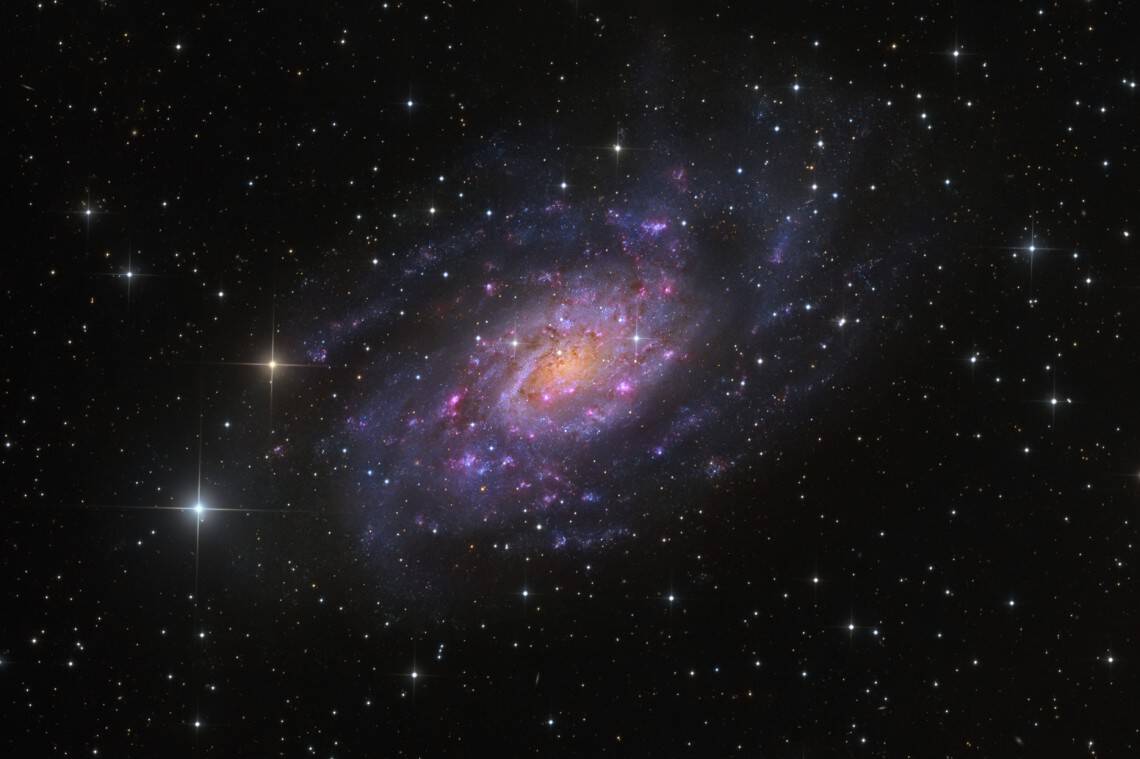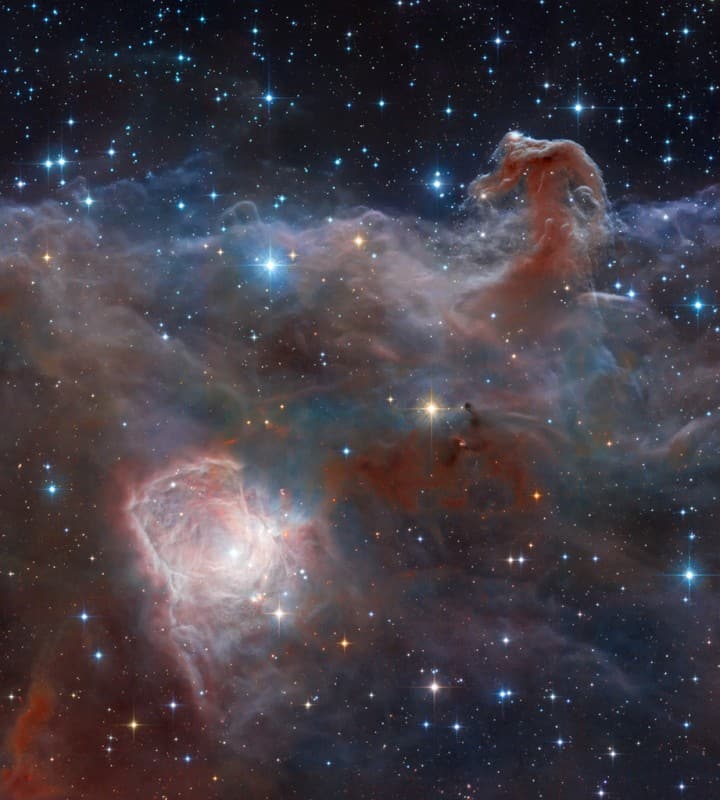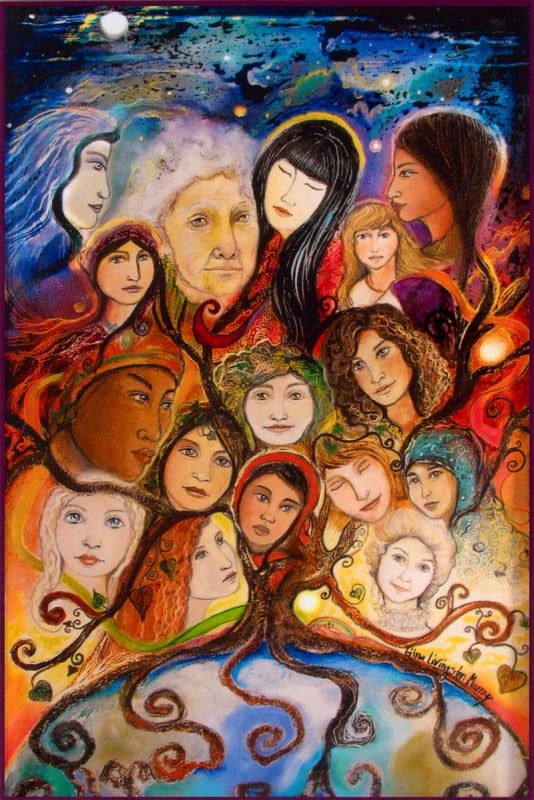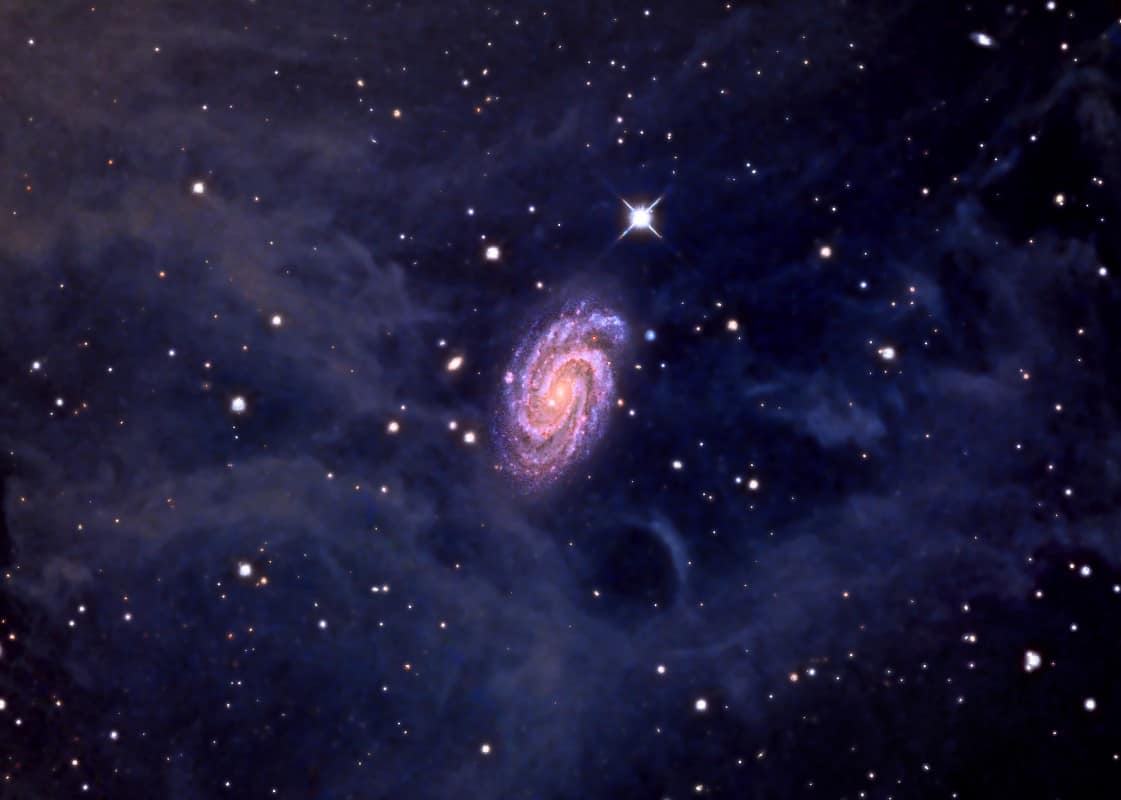Blog
Renata Rosa born in Sao Paulo, Brazil, in 1973.
more...NGC 2403 (also Caldwell 7) is an intermediate spiral galaxy in the constellation Camelopardalis. NGC 2403 is an outlying member of the M81 Group, and is approximately 8 million light-years distant. It bears a striking similarity to M33, being about 50,000 light years in diameter and containing numerous star-forming H II regions. The northern spiral arm connects it to a Star forming region NGC 2404. NGC 2403 can be observed using 10×50 binoculars.
The galaxy was discovered by William Herschel in 1788. Allan Sandage detected Cepheid variables in NGC 2403 using the Hale telescope, giving it the distinction of being the first galaxy beyond the Local Group within which a Cepheid was discovered. He derived a distance of a mere 8 thousand light years. Today, it is thought to be a thousand times further away at about 8 million light years (2.5 Mpc).
more...Ronnie Earl (born Ronald Horvath, March 10, 1953, Queens, New York, United States) is an American blues guitarist and music instructor.
Earl collected blues, jazz, rock and soul records while growing up. He studied American History at C.W. Post College on Long Island for a year and a half, then moved to Boston to pursue a Bachelor’s Degree in Special Education and Education at Boston University where he would graduate in 1975.He spent a short time teaching handicapped children. During his college years, he attended a Muddy Waters concert at the Jazz Workshop in Boston. After seeing Waters perform, Earl took a serious interest in the guitar, which he had first picked up in 1973. His first job was as a rhythm guitarist at The Speakeasy, a blues club in Cambridge, Massachusetts. In addition to playing in the Boston blues scene, Earl traveled twice by Greyhound Bus to Chicago, where he was introduced to the Chicago blues scene by Koko Taylor.
Later he traveled to New Orleans and Austin, Texas, where he spent time with Kim Wilson, Jimmie Vaughan and The Fabulous Thunderbirds. In 1979 he joined the band Roomful of Blues as lead guitarist.
more...John Donald “Don” Abney (March 10, 1923 – January 20, 2000) was an American jazz pianist.
Abney was born in Baltimore, Maryland. He studied piano and french horn at the Manhattan School of Music, and he played the latter in an Army band during military service.
After returning from the army he played in ensembles with Wilbur de Paris, Bill Harris, Kai Winding, Chuck Wayne, Sy Oliver, and Louis Bellson. He had a sustained career as a session musician, playing on recordings for Louis Armstrong, Benny Carter, Oscar Pettiford, Ella Fitzgerald, Carmen McRae, Sarah Vaughan, Eartha Kitt, and Pearl Bailey. He also played on a large number of recordings for more minor musicians and on R&B, pop, rock, and doo wop releases.
more...” Mamadou Diabaté is a kora player. He began playing quite early in his life, became known as a musician in the area of Mali in which he lived, and has since moved to the United States, recording five albums.”
more...Combined image data from the massive, ground-based VISTA telescope and the Hubble Space Telescope was used to create this wide perspective of the interstellar landscape surrounding the famous Horsehead Nebula. Captured at near-infrared wavelengths, the region’s dusty molecular cloud sprawls across the scene that covers an angle about two-thirds the size of the Full Moon on the sky. Left to right the frame spans just over 10 light-years at the Horsehead’s estimated distance of 1,600 light-years. Also known as Barnard 33, the still recognizable Horsehead Nebula stands at the upper right, the near-infrared glow of a dusty pillar topped with newborn stars. Below and left, the bright reflection nebula NGC 2023 is itself the illuminated environs of a hot young star. Obscuring clouds below the base of the Horsehead and on the outskirts of NGC 2023 show the tell-tale far red emission of energetic jets, known as Herbig-Haro objects, also associated with newborn stars.
more...Zakir Hussain (Hindi: ज़ाकिर हुसैन, Urdu: ذاکِر حُسَین; born 9 March 1951) is an Indian tabla player in Hindustani classical music, musical producer, film actor and composer.
He was awarded the Padma Shri in 1988, and the Padma Bhushan in 2002, by the Government of India. He was also awarded the Sangeet Natak Akademi Award in 1990, given by the Sangeet Natak Akademi, India’s National Academy of Music, Dance & Drama. In 1999, he was awarded the United States National Endowment for the Arts‘ National Heritage Fellowship, the highest award given to traditional artists and musicians.
Hussain was born to the legendary tabla player Alla Rakha. He attended St. Michael’s High School in Mahim, and graduated from St. Xavier’s, Mumbai.
Hussain was a child prodigy. His father taught him Pakhawaj from the age of 3 years. Zakir’s father Alla Rakha belonged to the tradition of tabla-playing known as the Punjab baaj, one of the six main traditions (baaj) of north Indian tabla drumming, the others being Delhi, Benares, Ajrara, Farrukhabad, and Lucknow.
He was touring by the age of eleven. He went to the United States in 1969 to do his PhD at the University of Washington, receiving a doctorate in music. After that he began his international career, including more than 150 concert dates a year.
more...Lloyd Price (born March 9, 1933) is an American R&B vocalist, known as “Mr. Personality”, after one of his million-selling hits. His first recording, “Lawdy Miss Clawdy“, was a hit for Specialty Records in 1952. He continued to release records, but none were as popular until several years later, when he refined the New Orleans beat and achieved a series of national hits. He was inducted into the Rock and Roll Hall of Fame in 1998.
Price was born and grew up in Kenner, Louisiana, a suburb of New Orleans. He had formal training in playing the trumpet and piano, sang in his church’s gospel choir, and was a member of a combo in high school. His mother, Beatrice Price, owned the Fish ‘n’ Fry Restaurant, and Price picked up lifelong interests in business and food from her.
Art Rupe, the owner of Specialty Records, based in Los Angeles, came to New Orleans in 1952 to record the distinctive style of rhythm and blues developing there, which had been highly successful for his competitor Imperial Records. Rupe heard Price’s song “Lawdy Miss Clawdy” and wanted to record it. Because Price did not have a band, Rupe hired Dave Bartholomew to create the arrangements and Bartholomew’s band (plus Fats Domino on piano) to back Price in the recording session. The song was a massive hit. His next release, “Oooh, Oooh, Oooh”, cut at the same session, was a much smaller hit. Price continued making recordings for Speciality, but none of them reached the charts at that time.
In 1954, he was drafted and sent to Korea. When he returned he found he had been replaced by Little Richard. In addition, his former chauffeur, Larry Williams, was also recording for the label, having released “Short Fat Fannie“.
more...Randolph Denard Ornette Coleman (March 9, 1930– June 11, 2015) was an American jazz saxophonist, violinist, trumpeter, and composer. He was one of the major innovators of the free jazz movement of the 1960s, a term he invented with the name of his 1961 album. His “Broadway Blues” has become a standard and has been cited as a key work in the free jazz movement. He was awarded a MacArthur Fellowship in 1994. His album Sound Grammar received the 2007 Pulitzer Prize for music.
From the beginning of his career, Coleman’s music and playing were in many ways unorthodox. His approach to harmony and chord progression was far less rigid than that of bebop performers; he was increasingly interested in playing what he heard rather than fitting it into predetermined chorus-structures and harmonies. His raw, highly vocalized sound and penchant for playing “in the cracks” of the scale led many Los Angeles jazz musicians to regard Coleman’s playing as out-of-tune. He sometimes had difficulty finding like-minded musicians with whom to perform. Nevertheless, pianist Paul Bley was an early supporter and musical collaborator.
In 1958, Coleman led his first recording session for Contemporary, Something Else!!!!: The Music of Ornette Coleman. The session also featured trumpeter Don Cherry, drummer Billy Higgins, bassist Don Payne and Walter Norris on piano.
1959 was a notably productive year for Coleman. His last release on Contemporary was Tomorrow Is the Question!, a quartet album, with Shelly Manne on drums, and excluding the piano, which he would not use again until the 1990s. Next Coleman brought double bassist Charlie Haden – one of a handful of his most important collaborators – into a regular group with Cherry and Higgins. (All four had played with Paul Bley the previous year.) He signed a multi-album contract with Atlantic Records, who released The Shape of Jazz to Come in 1959. It was, according to critic Steve Huey, “a watershed event in the genesis of avant-garde jazz, profoundly steering its future course and throwing down a gauntlet that some still haven’t come to grips with.” While definitely – if somewhat loosely – blues-based and often quite melodic, the album’s compositions were considered at that time harmonically unusual and unstructured. Some musicians and critics saw Coleman as an iconoclast; others, including conductor Leonard Bernstein and composer Virgil Thomson regarded him as a genius and an innovator.”[12] Jazzwise listed it #3 on their list of the 100 best jazz albums of all time.
more...World Music on Flamenco Fridays with Sabicas.
Sabicas (nombre propio: Agustín Castellón Campos) (16 de marzo de 1912 – 14 de abril de 1990) fue un guitarrista flamenco de origen romaní.
Sabicas nació en Pamplona, España, y comenzó a tocar la guitarra a la edad de cinco años e hizo su debut en el espectáculo dos años después. Su estilo temprano fue influenciado por Ramón Montoya, a quien se relacionó por el lado de su madre de la familia. La amplia colaboración con importantes cantaores (cantaores flamencos) de la época lo ayudó a desarrollar su estilo personal.
https://www.youtube.com/watch?v=914BKzWaxj4
more...This beautiful telescopic skyscape features spiral galaxy NGC 918. The island universe is about 50,000 light-years across and lies some 60 million light-years away toward the constellation Aries. An artistic presentation, the image shows spiky foreground stars in our own Milky Way Galaxy and convoluted dust clouds that hang hundreds of light-years above our galactic plane, dimly reflecting starlight. It also captures NGC 918 in a cosmic moment important to astrophysicists on planet Earth. Light from supernova SN2009js, absent in previous images, is indicated by the two lines just below and left of the galaxy’s center. The supernova itself is the death explosion of a massive star within the plane of galaxy NGC 918. It was just discovered in October by supernova search teams in Japan and the US.
more...Gábor István Szabó (8 March 1936 – 26 February 1982) was a guitarist whose style incorporated jazz, pop, rock, and Hungarian music.
Gábor Szabó was born in Budapest, Hungary, and began playing guitar at the age of 14, inspired by jazz music heard on Voice of America radio broadcasts.[1] He escaped Communist Hungary in 1956, the year of the attempted revolt against Soviet-dominated Communist rule, and moved to the United States where he attended the Berklee School of Music in Boston.
more...George Edward Coleman (born March 8, 1935) is an American jazz saxophonist known for his work with Miles Davis and Herbie Hancock in the 1960s. In 2015, he was named an NEA Jazz Master.
Coleman was born in Memphis, Tennessee. He was taught how to play the alto saxophone in his teens by his older brother Lucian Adams, inspired (like many jazz musicians of his generation) by Charlie Parker. Among his schoolmates were Harold Mabern, Booker Little, Frank Strozier, Hank Crawford, and Charles Lloyd.
more...| Mississippi John Hurt | |
|---|---|

|
John Smith Hurt (possibly March 3, 1892 – November 2, 1966), better known as Mississippi John Hurt, was an American country bluessinger and guitarist.
Raised in Avalon, Mississippi, Hurt taught himself to play the guitar around the age of nine. He worked as a sharecropper and began playing at dances and parties, singing to a melodious fingerpicked accompaniment. His first recordings, made for Okeh Records in 1928, were commercial failures, and he continued to work as a farmer.
Dick Spottswood and Tom Hoskins, a blues enthusiast, located Hurt in 1963 and persuaded him to move to Washington, D.C.[5] He was recorded by the Library of Congress in 1964. This helped further the American folk music revival, which led to the rediscovery of many other bluesmen of Hurt’s era. Hurt performed on the university and coffeehouse concert circuit with other Delta blues musicians who were brought out of retirement. He also recorded several albums for Vanguard Records.
Hurt returned to Mississippi, where he died, in Grenada, a year later.
Material recorded by him has been re-released by many record labels. His songs have been recorded by Bob Dylan, Dave Van Ronk, Jerry Garcia, Beck, Doc Watson, John McCutcheon, Taj Mahal, Bruce Cockburn, David Johansen, Bill Morrissey, Gillian Welch, Josh Ritter, Guthrie Thomas, Parsonsfield, and Rory Block.
more...Gabacho Maroc is a French group which performs a captivating fusion of North African traditions, jazz and trance music.
more...More Posts
- The Cosmos with Abell 3827
- Keith Moon
- Terje Rypdal
- Gil Coggins
- Wynona Carr
- World Music with Li Baomei & Jiang Zhongde
- Daily Roots with Joggo ft. Lutan Fyah
- The Cosmos with M78
- Donna Godchaux
- Dale Hawkins
- Malachi Favors
- Sonny Thompson
- John Lee Hooker
- Claude Debussy
- World Music with Kaushiki Chakraborty
- Daily Roots with Rod Anton
- The Cosmos with IC 1396
- Clydie Mae King
- Art Farmer
- Count Basie




